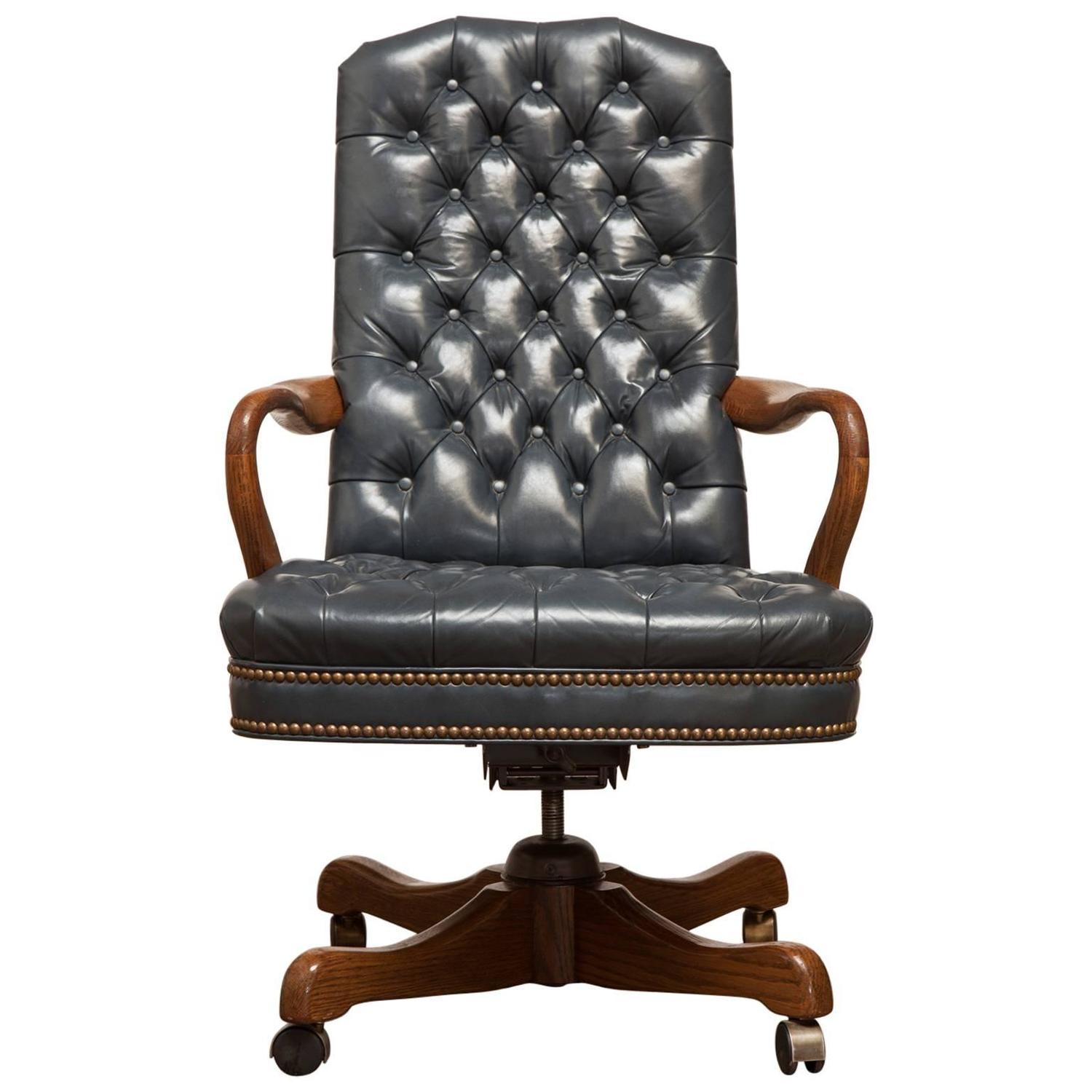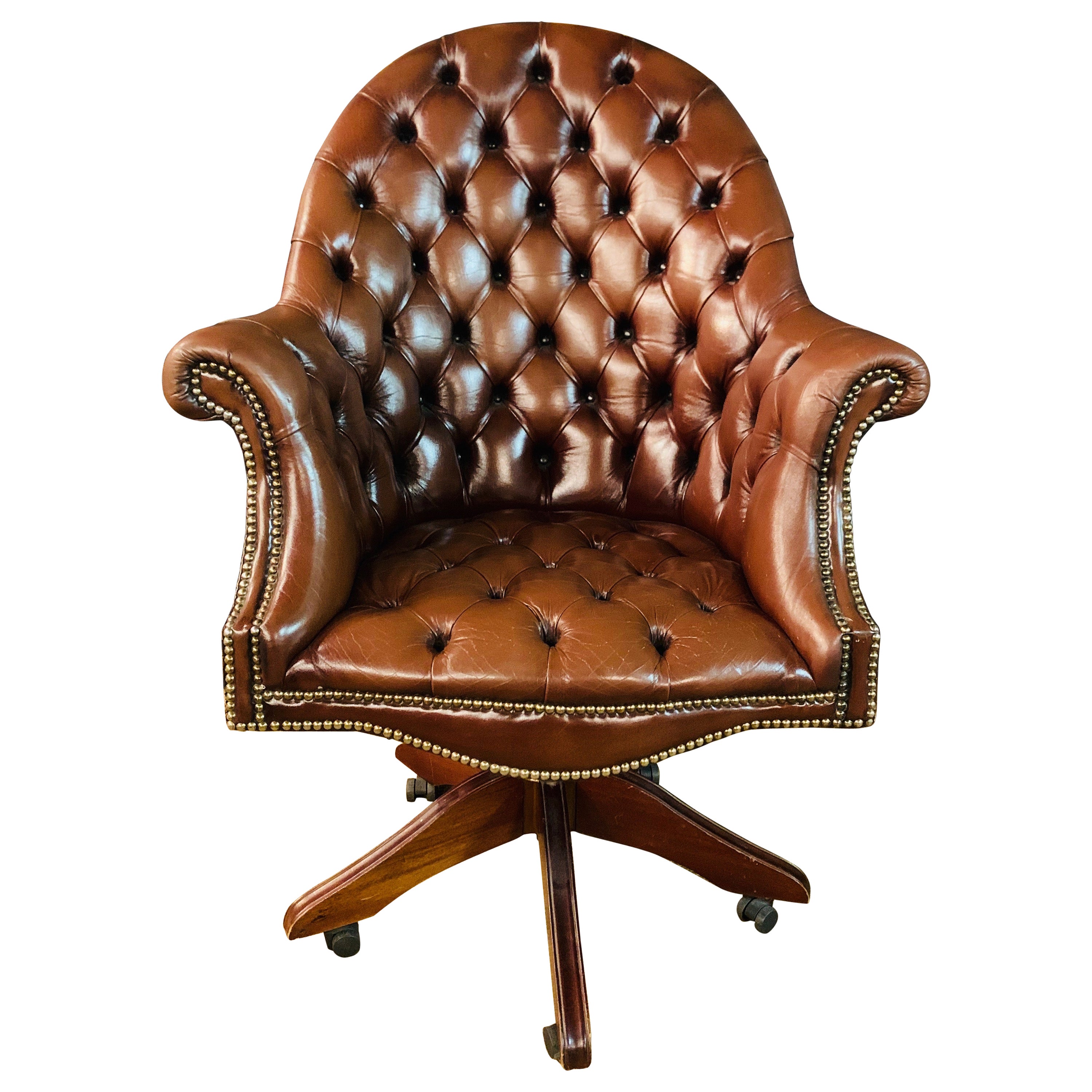Product Overview: Tufted Leather Desk Chairs

Tufted leather desk chairs represent a blend of comfort, style, and durability, making them a popular choice for home offices and executive settings. Their aesthetic appeal stems from the intricate detailing of the tufting, which adds texture and visual interest to the overall design. This classic element, combined with the inherent luxury associated with leather, creates a sophisticated and timeless look. Variations in design allow for integration into a wide range of interior styles.
The aesthetic appeal of tufted leather desk chairs is multifaceted. The prominent feature, the tufting, involves strategically placed buttons or studs that create a patterned effect on the leather or upholstery. This detail adds depth and dimension to the chair’s surface, transforming a simple design into a statement piece. Variations in tufting patterns, from simple diamond patterns to more intricate designs, allow for personalization and stylistic flexibility. Beyond the tufting, other design elements such as the chair’s shape, legs, and armrests contribute to its overall aesthetic. For example, a curved backrest can provide ergonomic support while also contributing to a more traditional feel, while a straight backrest might be favored in a modern design.
Materials Used in Tufted Leather Desk Chairs
Beyond genuine leather, a variety of materials are employed in the construction of tufted desk chairs to cater to different budgets and preferences. Faux leather, also known as synthetic leather, offers a more affordable alternative while mimicking the appearance and feel of genuine leather. Its durability varies depending on the quality of the material, but it generally requires less maintenance than real leather. Other upholstery options include various fabrics, such as velvet, linen, or microfiber, each providing a unique texture and aesthetic. These fabrics often offer a wider range of colors and patterns compared to leather options. The choice of material significantly impacts both the price and the overall feel of the chair. High-quality leather will typically be more expensive but also more durable and luxurious, while faux leather or fabric options offer more budget-friendly choices.
Comparative Analysis of Tufted Leather Desk Chair Styles
Different styles of tufted leather desk chairs cater to diverse tastes and interior design preferences. The following table compares three popular styles:
| Style | Material | Price Range | Key Features |
|---|---|---|---|
| Traditional | Genuine Leather, sometimes velvet | $500 – $2000+ | Ornate details, high backs, rolled arms, often carved wooden legs |
| Mid-Century Modern | Genuine Leather, Faux Leather | $300 – $1500 | Sleek lines, tapered legs, often minimalist tufting patterns, clean design |
| Modern | Genuine Leather, Faux Leather, Fabric | $200 – $1000+ | Bold colors, unconventional shapes, potentially unique tufting patterns, may incorporate metal accents |
Manufacturing Process of a Tufted Leather Desk Chair
The creation of a tufted leather desk chair is a multi-step process involving skilled craftsmanship and precise manufacturing techniques. The process begins with the design phase, where the chair’s dimensions, style, and materials are determined. This is followed by the creation of a frame, typically made from hardwood such as oak or beech, which provides the structural integrity of the chair. Once the frame is constructed, the chosen upholstery material (leather, faux leather, or fabric) is carefully measured and cut to fit the chair’s contours. The tufting process itself involves strategically placing buttons or studs through the upholstery and into the underlying padding, creating the characteristic patterned effect. Finally, the finished upholstery is attached to the frame, and the chair’s legs are affixed. Quality control checks are performed at various stages of the process to ensure the chair meets the desired standards of quality and durability. The final product represents a culmination of design, craftsmanship, and manufacturing expertise.
Market Analysis and Target Audience

The market for high-end office furniture, specifically tufted leather desk chairs, is driven by a segment of consumers prioritizing both comfort and aesthetic appeal in their workspace. Understanding the demographics and psychographics of this target audience is crucial for effective marketing and product development. This analysis explores the key characteristics of these consumers and the pricing and marketing strategies employed by various brands.
The appeal of a tufted leather desk chair extends beyond mere functionality; it represents a statement about personal style and professional success. The chair becomes an integral part of the user’s self-expression and workspace identity.
Target Consumer Demographics and Psychographics
Several key characteristics define the ideal customer for a tufted leather desk chair. These individuals are typically discerning buyers, valuing quality craftsmanship and lasting durability. They are less price-sensitive than those seeking budget-friendly options and place a higher premium on aesthetic appeal and long-term value.
- Age: Primarily 30-55 years old, although younger professionals with established careers may also be included.
- Income: Higher disposable income, reflecting their ability to afford premium furniture.
- Occupation: Professionals in fields such as law, finance, design, or entrepreneurship who value a sophisticated and comfortable workspace.
- Lifestyle: Often appreciate quality and craftsmanship in other aspects of their lives, possibly owning other high-end furniture or accessories.
- Psychographics: Value quality, comfort, style, and status. They are likely to be image-conscious and appreciate the prestige associated with owning a high-quality leather chair.
Pricing Strategies for Tufted Leather Desk Chairs
Pricing strategies for tufted leather desk chairs are highly variable, reflecting the wide range of materials, features, and brand reputations. The price point is directly influenced by the quality of the leather, the type of wood used in the frame, the complexity of the tufting, and the brand’s perceived value.
- Entry-Level Chairs: These chairs typically utilize bonded leather or lower-grade genuine leather, simpler tufting patterns, and less expensive wood frames. Prices generally range from $300 to $800.
- Mid-Range Chairs: These chairs often feature higher-quality genuine leather, more intricate tufting, and potentially some ergonomic features. Prices typically fall between $800 and $2000.
- High-End Chairs: These chairs are made with premium full-grain leather, complex tufting designs, high-quality wood frames, and advanced ergonomic features. Prices can range from $2000 to upwards of $5000 or more, depending on the brand and customization options.
Marketing Approaches of Different Brands
Different brands employ diverse marketing approaches to reach their target audience. Some focus on online marketing, while others leverage traditional channels or a combination of both. Brand positioning and messaging are key differentiating factors.
- Online Marketing: Many brands utilize targeted advertising on social media platforms (Instagram, Facebook), search engine optimization (), and influencer marketing to reach potential customers online. High-quality product photography and videos are essential components of this strategy.
- Traditional Marketing: Some brands may utilize print advertising in design or lifestyle magazines, catalog marketing, or collaborations with interior designers and architects to reach their target audience through more traditional channels.
- Brand Storytelling: Effective marketing often involves storytelling, highlighting the craftsmanship, history, and legacy of the brand. This approach builds trust and connects with consumers on an emotional level.
- Retail Partnerships: Strategic partnerships with high-end furniture retailers and showrooms provide access to a curated customer base and a physical presence to showcase the product.
Care and Maintenance of Tufted Leather Desk Chairs

Proper care and maintenance are crucial for extending the lifespan of a tufted leather desk chair and preserving its luxurious appearance. Neglecting these aspects can lead to premature wear and tear, diminishing both the aesthetic appeal and the functional value of the chair. This section details a comprehensive cleaning and maintenance regimen, along with practical tips for preventing damage and addressing common issues.
Cleaning and Maintaining Tufted Leather Desk Chairs
Maintaining a tufted leather desk chair requires a tailored approach depending on the type of leather and upholstery. The following steps provide a general guideline, but always refer to the manufacturer’s instructions for specific recommendations.
- Regular Dusting: Use a soft, dry cloth or a microfiber duster to regularly remove dust and debris. This prevents the accumulation of dirt that can scratch the leather over time. Focus on crevices and tufted areas where dust tends to settle.
- Spot Cleaning: For minor spills or stains, immediately blot (don’t rub!) the affected area with a clean, damp cloth. Avoid using excessive water. For tougher stains, use a leather cleaner specifically designed for the type of leather (e.g., aniline, semi-aniline, top-grain) on a small, inconspicuous area first to test for colorfastness.
- Conditioning: Condition the leather regularly, typically every 3-6 months, using a high-quality leather conditioner. This helps maintain the leather’s suppleness and prevents it from drying out and cracking. Apply a small amount of conditioner to a soft cloth and rub it gently into the leather, following the grain.
- Cleaning Full-Grain Leather: Full-grain leather is the most durable and requires minimal cleaning. Regular dusting and occasional conditioning are usually sufficient. For stubborn stains, use a mild soap solution and a soft sponge, followed by thorough drying and conditioning.
- Cleaning Top-Grain Leather: Top-grain leather is more susceptible to scratches and requires more careful cleaning. Use a specialized leather cleaner and conditioner formulated for this type of leather. Avoid harsh chemicals or abrasive cleaners.
- Upholstery Cleaning: For chairs with fabric upholstery accents, vacuum regularly using a soft brush attachment. Spot clean spills immediately using a suitable upholstery cleaner. Always test the cleaner on an inconspicuous area first.
Extending the Lifespan of a Tufted Leather Desk Chair
Regular cleaning and conditioning are vital. Avoid exposing the chair to direct sunlight or excessive heat, which can cause the leather to fade and crack. Keep the chair away from sources of moisture to prevent mold and mildew. Protect the leather from sharp objects and abrasive materials. For minor scratches, you can try using a leather repair kit or contacting a professional leather restoration service. Regularly inspect the chair for loose stitching or damaged components and address these issues promptly to prevent further damage. Proper posture and avoiding excessive weight on the chair will also extend its lifespan.
Proper Storage of a Tufted Leather Desk Chair
Imagine the chair carefully wrapped in a breathable, dust-proof cover, such as a large, soft cotton sheet. The chair is then placed in a cool, dry environment, away from direct sunlight and sources of moisture. Ideally, it would be stored upright to maintain its shape and prevent sagging. For long-term storage, consider placing it in a climate-controlled environment to minimize the risk of damage from temperature and humidity fluctuations. Avoid stacking other items on top of the stored chair.
